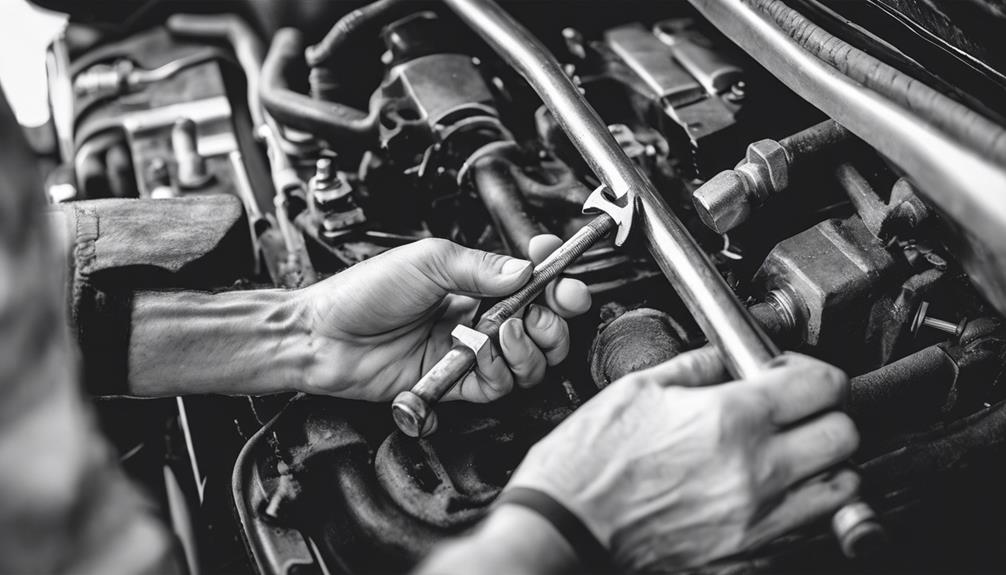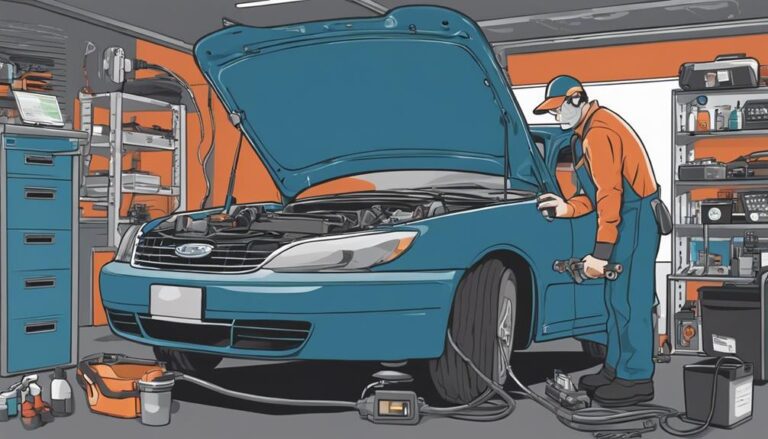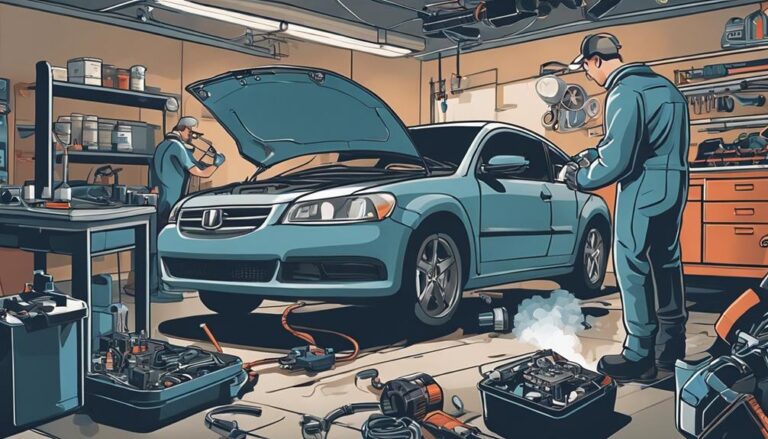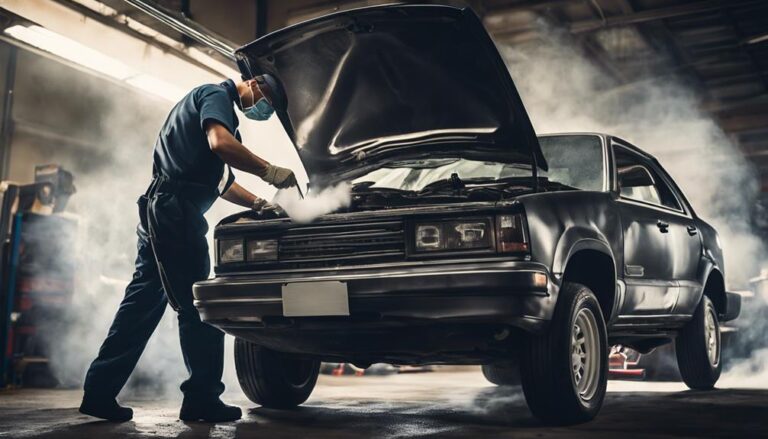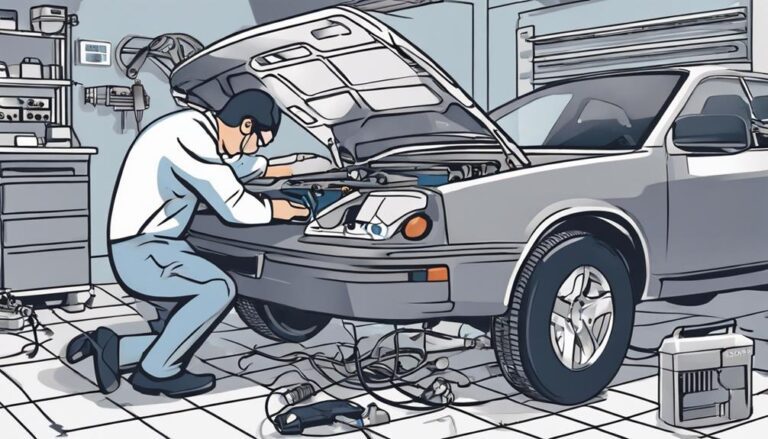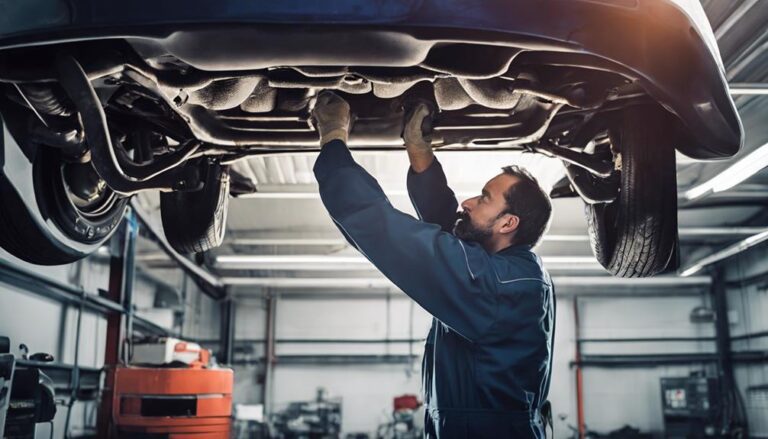7 Best DIY Tips for Emission System Repairs
If you've ever wondered how to tackle emission system repairs on your own, these 7 best DIY tips will give you a head start towards smoother-running vehicles and cleaner emissions.
From simple fixes like tightening a gas cap to more intricate tasks involving sensor replacements, this guide will equip you with practical strategies to address common emission system issues effectively.
Whether you're a novice or a seasoned DIY enthusiast, mastering these tips could save you time and money while enhancing your automotive skills.
Key Takeaways
- Regular maintenance ensures optimal emission system operation.
- Timely address symptoms like check engine light for efficient repairs.
- Essential tools like OBD-II scanner and multimeter aid in diagnostics.
- Prioritize safety protocols, proper tools, and accurate component replacement for effective repairs.
Understanding Emission System Basics
Have you ever wondered how your vehicle's emission system works to control harmful gases and reduce environmental impact?
The emission system is a critical component designed to reduce pollutants such as carbon monoxide (CO), hydrocarbons (HC), and nitrogen oxides (NOx) that are harmful to the environment. This system consists of various components, including sensors, engine controls, and exhaust parts, all working together to make sure your vehicle operates efficiently while minimizing its environmental footprint.
Proper maintenance of the emission system is important to uphold vehicle efficiency and reduce the impact on the environment. Faulty sensors, such as oxygen sensors, can lead to decreased performance and increased emissions. Understanding the basics of the emission system is key to diagnosing issues promptly and accurately. By grasping how each component functions within the system, you can address problems effectively, ensuring your vehicle runs smoothly and stays environmentally friendly.
Regular maintenance and timely repairs are crucial to keep your emission system operating optimally and to minimize your vehicle's negative impact on the environment.
Identifying Common Emission System Issues
To effectively identify common emission system issues, begin by understanding the key components and their functions within the system. The table below outlines some common problems associated with the emission system that you may encounter:
| Component | Common Issue | Symptoms |
|---|---|---|
| Oxygen Sensor | Faulty sensor | Check Engine light, decreased fuel efficiency |
| Catalytic Converter | Clogged converter | Decreased fuel efficiency, unusual odors from exhaust |
| Check Engine Light | Various underlying issues | Engine misfires, loud noises |
When dealing with emission system problems, pay close attention to these components as they play an important role in the system's performance. If you notice any of the listed symptoms, it is important to address them promptly to prevent further damage and maintain your vehicle's efficiency. Regular maintenance is key to ensuring the emission system functions correctly, so stay proactive in your approach to keep your vehicle running smoothly.
Tools Needed for DIY Emission Repairs
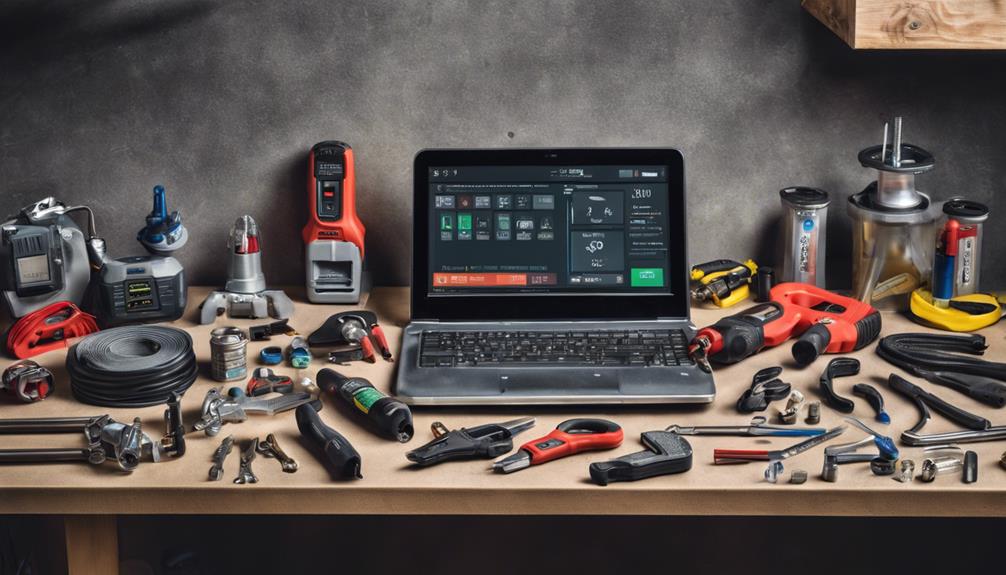
When conducting DIY emission repairs, the essential tools required include an OBD-II scanner, a multimeter, a vacuum gauge, a socket set, and a torque wrench.
An OBD-II scanner is essential for reading trouble codes and diagnosing issues within the vehicle's emission system. The multimeter aids in conducting electrical tests to make sure components are functioning correctly. A vacuum gauge helps in detecting vacuum leaks, which can impact emissions. The socket set is necessary for removing various components during repairs, while the torque wrench guarantees proper tightening to prevent leaks and ensure best performance.
Additionally, safety equipment such as gloves, safety glasses, and a fire extinguisher should always be used to protect yourself while working on the emission system. Having these tools at hand will enable you to efficiently diagnose and repair emission system problems, promoting a sense of accomplishment and belonging among DIY enthusiasts.
Step-by-Step Emission System Inspection
To conduct a thorough inspection of your vehicle's emission system, start by checking the importance and condition of the gas cap. Make sure it forms a proper seal to prevent any leaks that could affect emissions.
Utilize an OBD-II scanner to retrieve error codes and identify potential issues within the emission system accurately.
Inspect the catalytic converter for any signs of damage or blockages that might impact emissions output.
Look closely for corrosion or loose wiring connections that could disrupt the functionality of components in the emission system.
Remember, seeking assistance from professional mechanics is essential for an accurate diagnosis and effective repair solutions based on the findings of your inspection.
- Check the gas cap seal for tightness and visible damage.
- Utilize an OBD-II scanner to retrieve error codes.
- Inspect the catalytic converter for damage or blockages.
- Look for corrosion and loose wiring connections in the emission system.
DIY Emission System Maintenance Techniques
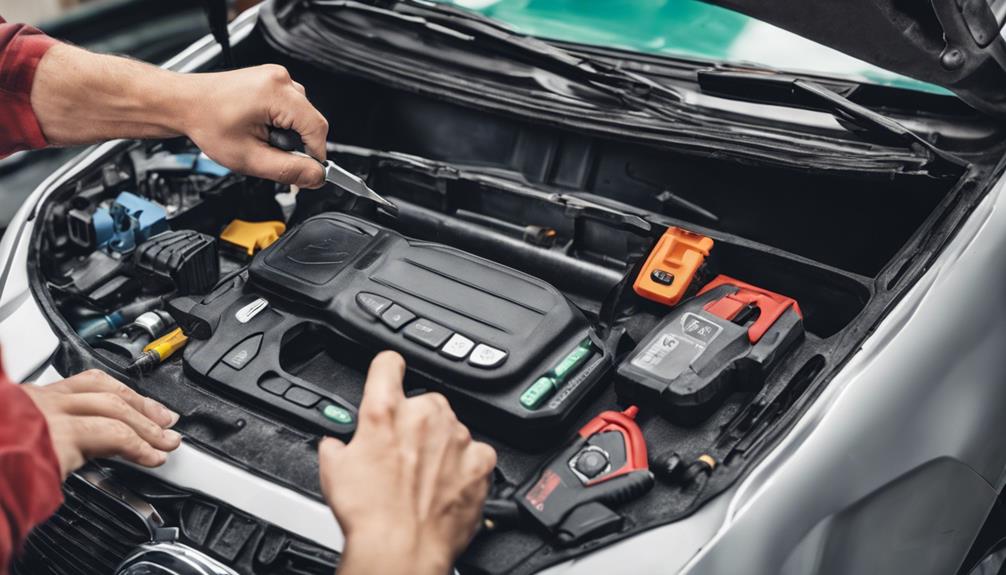
When maintaining your vehicle's emission system, consider starting with Emission System Diagnostics to pinpoint any issues accurately.
Next, focus on Emission System Component Cleaning to guarantee peak performance and reduce harmful emissions.
Lastly, prioritize Emission System Leak Detection to prevent leaks that could lead to system malfunctions and increased emissions.
Emission System Diagnostics
For efficient DIY emission system maintenance, start by utilizing an OBD-II scanner to diagnose potential issues at home. Here are some tips to help you with emission system diagnostics:
- Check the oxygen sensors for proper functioning.
- Inspect the catalytic converter for signs of damage.
- Test the EGR valve to make sure it's working correctly.
- Look for vacuum leaks by examining hoses and connections in the system.
Emission System Component Cleaning
If you've identified any issues during your emission system diagnostics, it's time to address them through proper cleaning of the system components for superior performance.
Start by cleaning the oxygen sensor to enhance fuel efficiency and reduce emissions.
Guarantee proper air intake by cleaning or replacing a dirty air filter in the emission system.
Using a catalytic converter cleaner can help eliminate carbon buildup, improving exhaust emission performance.
Don't forget to inspect and clean the EGR valve to prevent engine knocking and reduce harmful gas emissions.
Regularly cleaning the PCV valve is essential for maintaining proper crankcase ventilation and decreasing engine emissions.
Emission System Leak Detection
To effectively detect emission system leaks as part of your DIY maintenance routine, consider utilizing a smoke machine to pressurize the system and pinpoint areas where smoke escapes, indicating potential leaks.
Here are some additional practical tips to assist you in detecting and addressing emission system leaks:
- Check for leaks around gaskets, hoses, and connections using soapy water to create bubbles where leaks are present.
- Inspect the exhaust system for holes or rust spots that could indicate leaks affecting emission performance.
- Use a handheld vacuum pump to test components like the EGR valve for leaks by applying vacuum and monitoring for loss of pressure.
- Look for signs of black soot or residue around potential leak points to identify areas needing repair in the emission system.
Fixing Emission System Leaks at Home
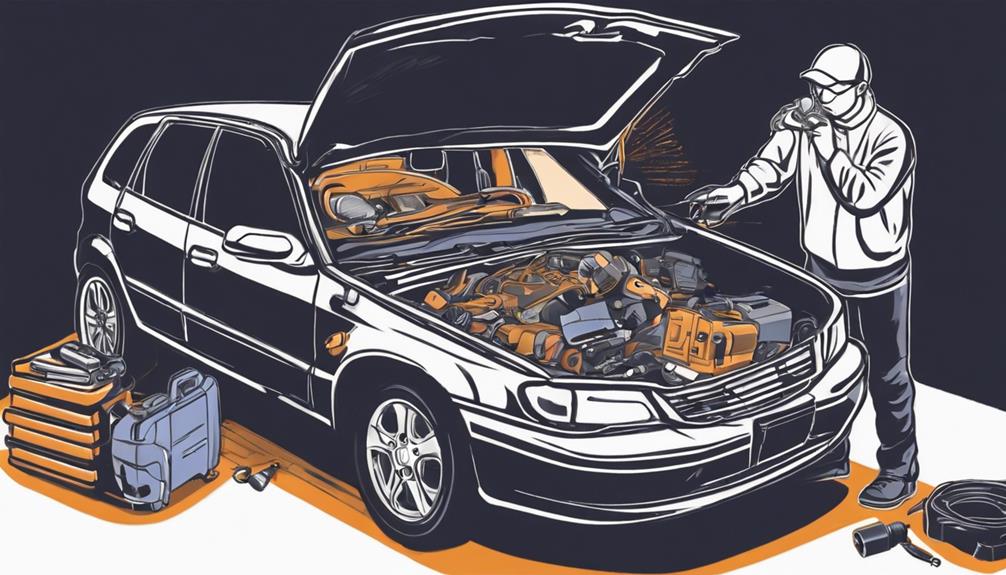
When tackling emission system leaks at home, start by identifying the source through a thorough inspection for visible signs of damage or corrosion. Use a smoke machine to introduce smoke into the system, making leaks visible where the smoke escapes. This method helps pinpoint the exact location of the leak.
For minor leaks, consider using high-temperature silicone sealant designed for exhaust systems. This sealant can provide a temporary fix until a more permanent solution is applied. Remember to replace any damaged gaskets or components causing the leak to guarantee a long-term resolution.
It's important to check the entire exhaust system, including the muffler, catalytic converter, and exhaust pipes, for leaks. This detailed inspection can help prevent further emission system issues and maintain the efficiency of your vehicle's exhaust system.
Replacing Emission System Components Safely
Before starting the replacement process, guarantee you disconnect the battery to prevent any electrical incidents.
Wear appropriate safety gear like gloves and eye protection to safeguard yourself during the procedure.
Remember to follow the manufacturer's instructions and torque specifications when installing new components to maintain the system's integrity.
Safety Protocols for Replacement
Guarantee your safety during emission system component replacements by following these essential protocols:
- Disconnect the battery: Guarantee electrical mishaps by disconnecting the battery before starting any replacement.
- Wear safety gear: Safeguard yourself with gloves and eye protection to protect against harmful chemicals and sharp edges.
- Use jack stands and wheel chocks: Guarantee stability and prevent accidents by using jack stands and wheel chocks when working underneath the vehicle.
- Follow instructions and torque specifications: Install new components correctly by adhering to the manufacturer's instructions and torque specifications for proper functioning.
Proper Tools and Equipment
To safely replace emission system components, make sure you have the proper tools and equipment at hand. Essential tools include wrenches, sockets, and O2 sensor sockets for efficient component removal. Utilize a torque wrench to guarantee precise tightening, following manufacturer's instructions for correct specifications.
An OBD-II scanner is vital for diagnosing trouble codes and confirming the need for component replacement. Safety gear such as gloves, safety glasses, and a fire extinguisher should always be worn to prevent accidents. Elevate the vehicle securely using a jack stand before working on the exhaust system.
Check for Leaks
Inspecting your exhaust system for leaks is vital when replacing emission system components safely. Leaks, whether at joints, gaskets, or welds, can lead to emission problems, allowing harmful gases to escape and impacting proper emission control. To guarantee leaks are dealt with effectively, check for black soot marks or listen for hissing noises, indicating potential issues.
Promptly replacing damaged components like gaskets or seals guarantees a tight seal, preventing leaks. Properly sealing leaks in the emission system not only maintains proper emission control but can also enhance fuel efficiency, engine performance, and reduce environmental impact.
- Check for black soot marks or listen for hissing noises
- Promptly address leaks to prevent harmful gases from escaping
- Replace damaged components like gaskets or seals
- Enhance fuel efficiency by properly sealing leaks
Frequently Asked Questions
How Do You Fix Emission System Problems?
When fixing emission system problems, use an OBD scanner for accurate diagnosis. Replace faulty parts like oxygen sensors and catalytic converters. Check for vacuum leaks, EGR valve issues, and exhaust leaks. Confirm proper installation to prevent future problems.
How Do You Fix Emission Test Failure?
To fix emission test failure, start by addressing common issues like faulty oxygen sensors or catalytic converters. Follow maintenance guidelines, clear error codes, and perform DIY repairs to improve emission test readiness. Monitor components regularly for peak performance.
How Can I Improve My Engine Emissions?
To enhance your engine emissions, prioritize regular air filter changes, opt for high-quality fuel, maintain oxygen sensors, fix exhaust leaks promptly, and stick to a maintenance schedule. These steps contribute to better performance and eco-friendliness.
How Do You Pass Emissions With Check Engine Light?
To pass emissions with a Check Engine light on, diagnose and fix the issue triggering it. Confirm all emission monitors complete cycles. Avoid resetting lights before testing. Seek pro help for complex problems. Quick action prevents costly repairs and failures.
Conclusion
To sum up, by following the 7 Best DIY Tips for Emission System Repairs, you can effectively address common issues and maintain your vehicle's performance.
Remember, an ounce of prevention is worth a pound of cure, so regular maintenance and attention to detail can save you time and money in the long run.
Keep these tips in mind, and you'll be on the road to smoother sailing with your emission system.

